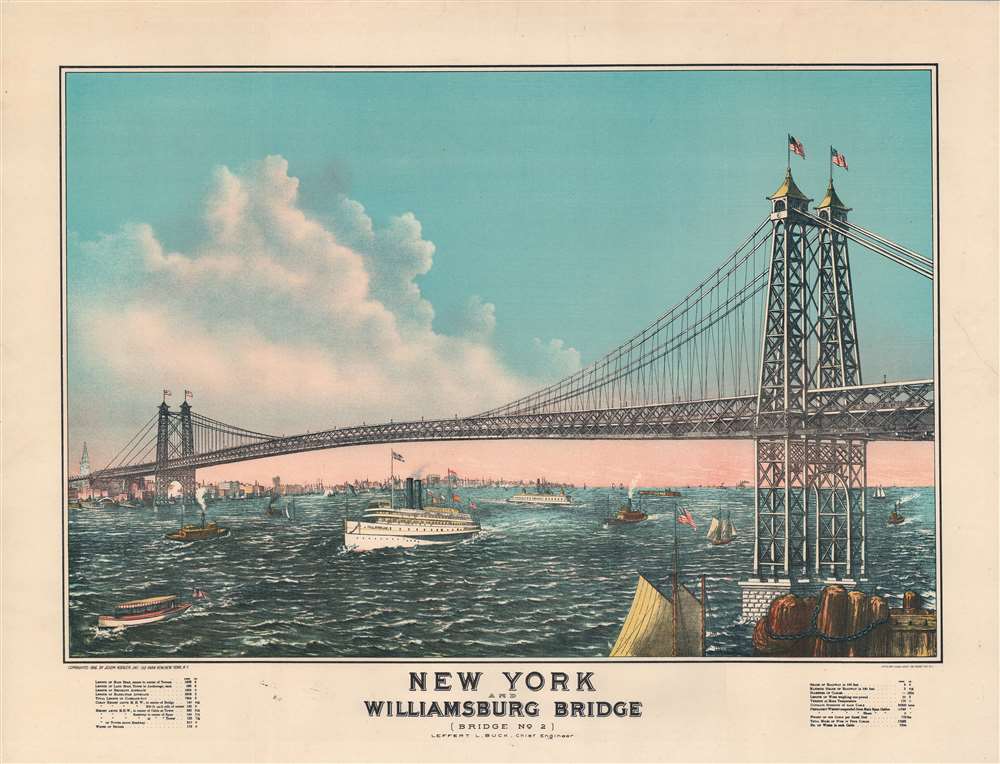1916 Koehler Chromolithograph View of the Williamsburg Bridge, New York City
WilliamsburgBridge-koehler-1916
Title
1916 (dated) 20 x 26 in (50.8 x 66.04 cm)
Description
A Closer Look
The view looks on the bridge from a dock in Brooklyn near Broadway. The Manhattan skyline is evident in the background. The present example is the 2nd edition, updated to include the distinctive Met Life Tower at the far left. In the foreground, the Fall River Line steamer Priscilla heads toward Boston. At the time, Priscilla was the largest side-wheeler afloat, capable of accommodating 1,500 passengers. Behind, another steam ferry, Oregon, operated by the Brooklyn and New-York Ferry Company, crosses the East River towards Brooklyn.Williamsburg Bridge
The Williamsburg Bridge is the second bridge (after the Brooklyn Bridge) to cross the East River between Brooklyn and Lower Manhattan. The bridge was constructed between 1896 and 1903,when it opened as the world's longest suspension bridge - a title it retained until 1924. The bridge was designed by Leffert L. Buck (chief engineer) and Henry Hornbostel (architect). The structure is unique among suspension bridges in that its main span hangs from cables in the usual manner, but its side spans are supported entirely by their trusswork. Initially, the Williamsburg Bridge was intended as a pedestrian, trolley, and railway bridge. In 1932, it was partially converted to accommodate vehicular traffic, but it remains a railroad bridge serving the J/Z and M Subway line.Chromolithography
Chromolithography is a color lithographic technique developed in the mid-19th century. The process involved using multiple lithographic stones, one for each color, to yield a rich composite effect. Oftentimes, the process would start with a black basecoat upon which subsequent colors were layered. Some chromolithographs used 30 or more separate lithographic stones to achieve the desired product. Chromolithograph color could also be effectively blended for even more dramatic results. The process became extremely popular in the late 19th and early 20th centuries, when it emerged as the dominant method of color printing. The vivid color chromolithography produced made it exceptionally effective for advertising and propaganda imagery.Publication History and Census
This view was first published in 1903. It was drawn and lithographed by Charles Hart and published by Joseph Koehler. The present 1916 edition was issued with minor revisions to include a new sky and the Met Life Tower, constructed in 1909. The 1916 edition also has a more vivid color palette. Koehler filed the copyright for this view on February 19, 1916. We note several examples of the 1903 first edition at the New York Public Library, the New York Historical Society, and the Library of Congress. However, this is the only known example of the 1916 edition.CartographerS
Joseph Koehler (1842 - May 22, 1933) was a New York based lithographer, printer, and stationer active in the late 19th and early 20th century. Koehler was born in near Reims, France, the son of a prominent medical doctor, also Joseph Koehler, once the personal physician to Napoleon Bonaparte. In 1846, when he was just 4, Koehler immigrated to the United States with his family, settling in New York City. He is tentatively credited with the invention of the 'greeting card' in 1867, when he was 21. Following on the success of his greeting card business, Koehler built an extensive postcard and calling card business, which today represents the bulk of his surviving corpus. Most of his pieces were printed at factories in Germany, France, and England. Later, in the 1890s, he established his own steam press operation at 150 Park Row - then a printing hub. Koehler, while a pioneer in half-tone printing, is better known for retaining the more labor-intensive chromolithographic process well into early 20th century due to its superior graphic effect. Most scholarship suggests he retired around 1914, but we have seen later work attributed to his firm dating to 1916, so this may be erroneous. In addition to his printing work, Koehler also imported tobacco and smoking paraphernalia. He also inherited the formula for a medicinal cure-all balm developed by his father, which he marketed as 'Arabian Balsam'. More by this mapmaker...
Charles Hart (March 10, 1824 - October 9, 1914) was a pioneering British-American lithographer active in New York from the mid-19th century to the early 20th century. Hart was born in London and immigrated to New York as a child. He briefly worked in a glassware shop before, in 1939, becoming an lithographer's apprentice under George Endicott (June 14, 1802 - 1848). Five years later in 1844 is graduated from his apprenticeship, joined the fully-paid staff of Endicott Lithography. He must have been greatly appreciated within the firm, as in 1850, his salary of 20 USD a week was among the highest in the trade. When the Endicott offices burnt to the ground in 1859, Hart moved to the firm of Robertson, Siebert and Shearman. When this partnership collapsed in 1861, Hart partnered with James Alpheus Sherman (1816 - 1890), creating the firm 'Shearman and Hart.' Shearman left the firm to peruse a legal career shortly thereafter and from this point forward, Hart published independently. Hart retired from active lithography in 1911, when his sons, Francis and Horace Hart, took over. He died in 1914. Learn More...

